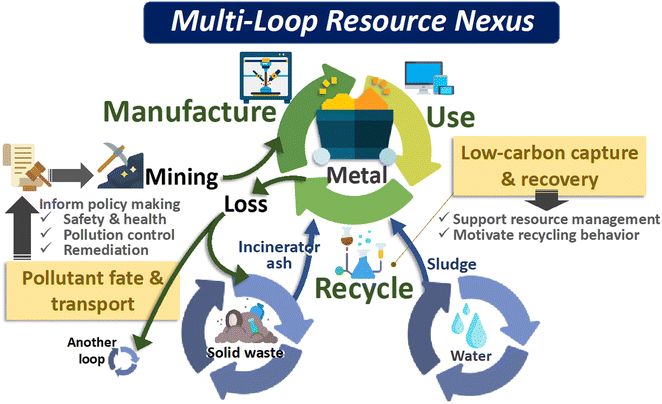 Open Access Article
Open Access ArticleCreative Commons Attribution 3.0 Unported Licence
Chemical sciences, technological innovations, and resource circulation
Iris K. M.
Yu

Department of Civil and Environmental Engineering, National University of Singapore, 1 Engineering Drive 2, 117576, Singapore. E-mail: irisyu@nus.edu.sg
First published on 5th October 2023
We are in the era of a technological bloom embracing the rise of artificial intelligence and big data technologies as well as the thriving fields of civil and environmental engineering, particularly towards sustainable development. These activities have driven up the demands for metals and minerals, which are necessary components of electronics, hardware, and infrastructure, and that has sparked discussion about mineral supply security.1 While we have an abundant element supply on Earth, the more critical question is how to sustainably acquire, use, and recycle the resources. The annual global production of iron ore is nearly 3 billion tonnes, followed by aluminium (65 million tonnes), manganese (56 million tonnes), chromium (37 million tonnes), copper (21 million tonnes), etc.2 The whole mining industry significantly accounts for 4–7% of the total global greenhouse gas emissions.3 Moreover, the mining and refining processes often release toxic chemicals to the air, soil, and groundwater, while raising human rights concerns about underpaid labour and the health and safety of the workers.4 Therefore, for the stewardship of the Earth's element resources, there is definitely room for improvement from the viewpoint of sustainability.
The chemical sciences play a fundamental role in the development of sustainable processes in element resources management. It is an indispensable tool to fulfil the technological need for achieving circular economies, where resources are turned into different forms with economic value within closed loops. Such an approach has been promoted worldwide as a pathway to sustainability. The ideal scenario of resource circulation would feature zero mining from the Earth’s crust and zero loss to low-value disposal. To the best of the author's understanding, a more realistic framework shall comprise multiple resource loops, which are connected in a way that output from one loop can enter another. Fig. 1 illustrates a simplified model of a multi-loop resource nexus. In the minerals loop, after mining and refining, the resources are used in manufacturing commodities, ranging from consumer products (computers, phones, electric cars) to large-scale facilities (solar panels, hydrogen transport and storage). At the end of service, metals are supposedly collected and repurposed into new products to close the loop, using science-informed recovery/extraction technologies. However, the loss to solid waste is unavoidable, especially when the cost of disposal outcompetes that of isolating metals from a mix of materials. Nevertheless, it is possible to return such “lost fractions” back to the metal cycle after municipal waste incineration. Recycling plants to mine both ferrous and non-ferrous metals from incinerator bottom ash have been established in Germany, the Netherlands, and Singapore.5 Likewise, sewage sludge that contains a high level of heavy metals can be processed and the extracted metals could then enter the metal loop. The model in Fig. 1 can be detailed with more interconnected loops to better represent the complexity of resource management in reality. It is foreseeable that the model can be optimized by cutting-edge data science to facilitate efficient transfer and transformation of resources for the greatest benefits. The concept of a multi-loop resource nexus highlights the potential synergies arising from the interactions among different circular economies.
Starting with mining, the chemical sciences can help with understanding the pollutant fate and transport across different environmental compartments (Fig. 1). The scientific findings will inform data-driven policy making and management frameworks to address the safety and health of workers, pollution control, and on-site remediation. The chemical sciences are also the cornerstone of innovation in low-carbon resource recovery technology, which is the prerequisite in circular economy development. Much attention has been given to the efficient and selective recovery of metals from batteries. Wang et al. tailored the deep eutectic solvent (DES) choline chloride–formic acid for extracting high-value elements from lithium-ion battery cathode materials at a mild temperature of 80 °C.6 Their findings highlighted that by applying mechanochemical pretreatment, the selectivity of the subsequent DES treatment was enhanced towards the extraction of lithium, nickel, cobalt, and manganese, while the non-target iron phosphate can be stabilized. In regard to the continued efforts on metal recovery from sludge, Yesil et al. reported a three-stage integrated process combining ultrasonication pretreatment, alkaline fermentation, and membrane technology, to extract chromium, copper, nickel, and zinc.7
Fruitful research outcomes extend to the stewardship of elements beyond metals, such as carbon. Zhang et al. discovered the use of an aluminium chloride-based ionic liquid for tandem cracking–alkylation of polyolefin plastics, producing liquid isoalkanes (C6 to C10) as renewable fuels.8 The ionic liquid medium was found to increase the plastic substrate reactivity and lower the energy of the ionic transition states. In addition, the approach integrated endothermic cracking and exothermic alkylation to achieve partial energy compensation. The novel system thereby enabled plastic conversion at temperatures below 100 °C. Such an exciting finding marks the milestone of polyethylene and polypropylene upcycling, offering a low-carbon pathway alternative to conventional practice. As for the utilization of natural polymers in biomass (e.g., food waste and agricultural waste), there are increasing pilot-scale and full-scale projects worldwide. For instance, in Singapore, the pilot test in 2016 proved the synergistic effect of co-digestion of food waste and sludge at 40 tonnes per day, which increased the biogas generation by 40% in a field-scale setting.9 The co-digestion strategy will be adopted for large-capacity processing in Tuas Nexus, the forthcoming integrated water and solid waste treatment facility.9 The abovementioned examples showcase the significance of the chemical sciences in unveiling reaction mechanisms and generating new knowledge, which will eventually lead to new designs of materials and methods for the sustainable management of Earth's limited resources.
From the socio-economic perspective, technology is the critical hardware that allows waste and resource management policy to function well leading to intended outcomes. While policy suppresses the business-as-usual practices by levying carbon taxes and waste charges, new technologies should be in place as timely solutions for the industry that may otherwise suffer, even incurring adverse impacts on the economy. In addition, the public should be informed of the availability of new technologies, which will motivate individual recycling behaviour within the community. In addition, apart from introducing monetized incentives and strengthening education on proper recycling, the value of an individual’s contribution should be clearly presented to them. While better communication between academia, industry, and governments has been advocated, perhaps it is time to involve the public to a greater extent. There is an increasing number of upcycling businesses with interesting concepts and new processes. Examples of products include jewellery made from recycled precious metals from electronics10 and eco-furniture made from used chopsticks11 and recycled plastics.12 The feasibility of such business models is palpable and their ideas are enticing – encouraging sustainable practices in the community. We shall leverage information sharing and visualize the impacts of individual behaviours to a wider audience, in order to foster self-driven recycling with less reliance on tangible rewards.
In summary, technological innovations are grounded in the chemical sciences and should act jointly with policy to actualize circular economies for the sustainable stewardship of Earth's element resources. Instead of a standalone entity, different circular economies can be interconnected via multidisciplinary research efforts to form a multi-loop resource nexus, which potentially generate synergies for maximized benefits (Fig. 1). The collection of innovative technologies also has the potential to stimulate individual recycling behaviours when the messages about “technology availability” and “impact of an individual's effort” can be well channelled to the public. Concerted efforts from all stakeholders in society are indispensable to overcome today's grand sustainability challenges.
References
- S. H. Ali, The US should get serious about mining critical minerals for clean energy, Nature, 2023, 615(7953), 563, DOI:10.1038/d41586-023-00790-y.
- Birmingham Centre for Strategic Elements and Critical Materials and the Critical Elements and Materials (CrEAM) Network, 2023, available at: https://www.birmingham.ac.uk/research/energy/research/centre-strategic-elements-critical-materials/securing-technology-critical-metals-for-britain.aspx Search PubMed.
- L. Delevingne, W. Glazener, L. Grégoir and K. Henderson, Climate risk and decarbonization: What every mining CEO needs to know, McKinsey Sustainability, 2020, available at: https://www.mckinsey.com/capabilities/sustainability/our-insights/climate-risk-and-decarbonization-what-every-mining-ceo-needs-to-know Search PubMed.
- J. Nayar, Not so “green” technology: the complicated legacy of rare earth mining, Harvard Internat. Rev., 2021, available at: https://hir.harvard.edu/not-so-green-technology-the-complicated-legacy-of-rare-earth-mining/ Search PubMed.
- Visits of recycling facilities for incinerator bottom ash, REMEX, 2023, available at: https://remex-processing.com/plant-visits Search PubMed.
- M. Wang, K. Liu, Z. Xu, S. Dutta, M. Valix, D. S. Alessi, L. Huang, J. B. Zimmerman and D. C. W. Tsang, Selective extraction of critical metals from spent lithium-ion batteries, Environ. Sci. Technol., 2023, 57, 3940–3950, DOI:10.1021/acs.est.2c07689.
- H. Yesil, R. Molaey, B. Calli and A. E. Tugtas, Removal and recovery of heavy metals from sewage sludge via three-stage integrated process, Chemosphere, 2021, 280, 130650, DOI:10.1016/j.chemosphere.2021.130650.
- W. Zhang, S. Kim, L. Wahl, R. Khare, L. Hale, J. Hu, D. M. Camaioni, O. Y. Gutiérrez, Y. Liu and J. A. Lercher, Low-temperature upcycling of polyolefins into liquid alkanes via tandem cracking-alkylation, Science, 2023, 379, 807–811, DOI:10.1126/science.ade7485.
- Co-digestion of food waste and used water sludge enhances biogas production for greater energy generation, National Environment Agency, Singapore, 2019, available at: https://www.nea.gov.sg/media/news/news/index/co-digestion-of-food-waste-and-used-water-sludge-enhances-biogas-production-for-greater-energy-generation Search PubMed.
- J. Bumpus, Your next necklace may have gold from an old phone, New York Times, 2022, available at: https://www.nytimes.com/2022/08/29/fashion/jewelry-electronic-mining-recycling.html Search PubMed.
- T. Visram, This company is turning chopsticks into furniture, FastCompany, 2023, available at: https://www.fastcompany.com/90876405/this-company-is-turning-chopsticks-into-furniture Search PubMed.
- J. Adhem, Paris Olympics to give waste a second life with recycled plastic chairs, Euronews, 2023, available at: https://www.euronews.com/green/2023/06/22/paris-olympics-to-give-waste-a-second-life-with-recycled-plastic-chairs Search PubMed.
| This journal is © The Royal Society of Chemistry 2023 |


